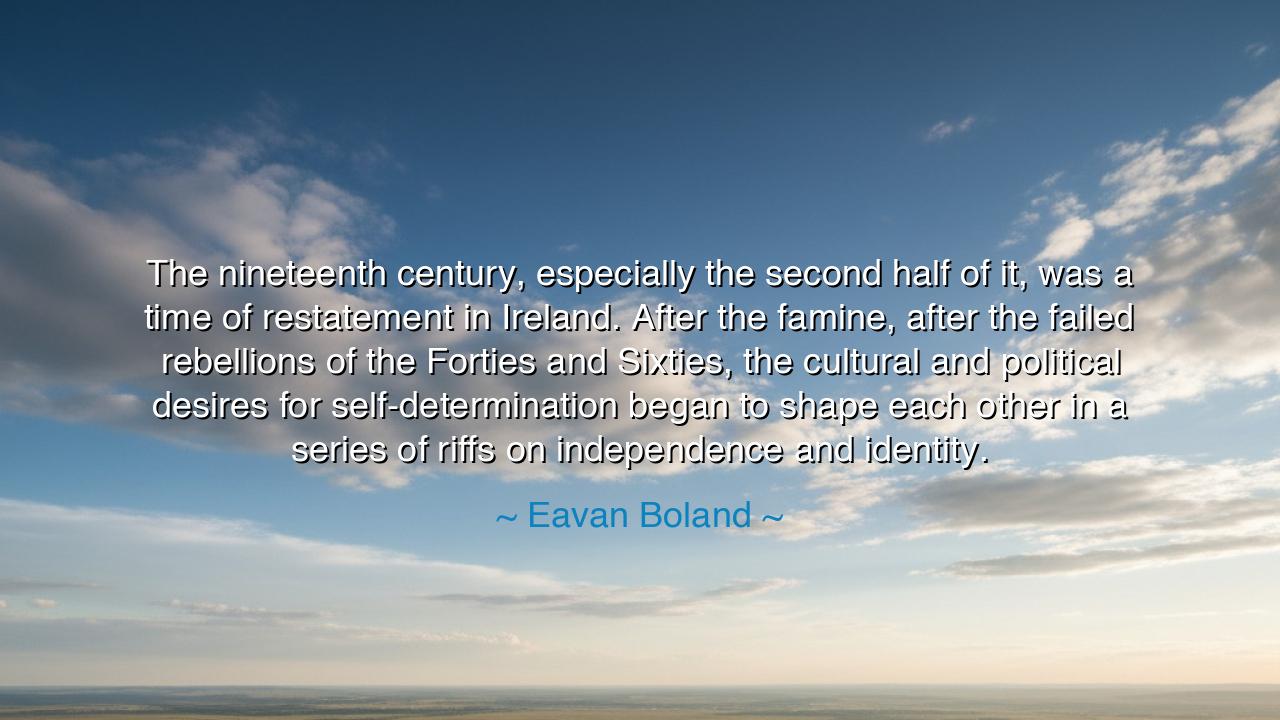
The nineteenth century, especially the second half of it, was a
The nineteenth century, especially the second half of it, was a time of restatement in Ireland. After the famine, after the failed rebellions of the Forties and Sixties, the cultural and political desires for self-determination began to shape each other in a series of riffs on independence and identity.






"The nineteenth century, especially the second half of it, was a time of restatement in Ireland. After the famine, after the failed rebellions of the Forties and Sixties, the cultural and political desires for self-determination began to shape each other in a series of riffs on independence and identity." – Eavan Boland
Hear now the words of Eavan Boland, poet of Ireland’s heart and keeper of her memory, for they speak not only of one nation’s past but of the eternal struggle between despair and rebirth. In these lines, Boland looks upon the nineteenth century not merely as a span of years, but as an age of reckoning — a time when a wounded people sought to rediscover themselves through the ashes of suffering. For Ireland, the century’s middle years were a crucible: the Great Famine, that dark tide of hunger and loss, had not only claimed a million lives but had tested the very soul of a people. And yet, from the desolation came a new stirring — a quiet insistence that identity could not perish, that independence could be reborn through art, language, and spirit.
The meaning of Boland’s reflection lies in her insight that nations, like men, are not defined by their defeats, but by their acts of restatement — by their ability to rise, redefine, and declare anew who they are. Ireland, after famine and failed rebellion, might have surrendered to silence. But instead, its people began to weave their sorrow into meaning, their loss into literature, their subjugation into songs of freedom. The “series of riffs” she speaks of are the many expressions of a single longing — that of self-determination, both political and cultural. In the quiet work of poets, painters, and dreamers, the foundation for Ireland’s eventual independence was laid long before the first shots of revolution were fired.
Consider the tale of Thomas Davis, the young poet and patriot who lived but a brief life in that same century. He wrote not with sword or musket, but with the pen, founding the newspaper The Nation and giving birth to the movement known as Young Ireland. Through his verses, he declared that “a nation’s strength is in its people’s hearts,” and that freedom must first be imagined before it can be won. He and his fellows sought to awaken a generation not only to political purpose but to cultural pride — to remind the Irish that they were heirs of poets, warriors, and saints, not merely subjects of empire. Though their rebellion in the 1840s failed, their words ignited a slow fire that would burn through the rest of the century.
Boland, as a poet herself, understood that the reclamation of identity often begins in the realm of imagination. After the revolts of the 1840s and 1860s — crushed as they were — came a quieter revolution: the revival of the Irish language, the preservation of folklore, the rediscovery of Celtic myth. Out of tragedy, the Irish began to rebuild their sense of self, to tell their own story once again. In her words, culture and politics became entwined, each shaping the other — for no nation can rise to independence until it knows who it is, and no identity can endure without the freedom to express it.
Thus, the “riffs on independence and identity” were not simply political speeches or military acts. They were the creation of poems, plays, and songs that reclaimed what history had tried to erase. The work of W.B. Yeats, Lady Gregory, and Douglas Hyde in the later decades of that century carried forward the legacy of the fallen rebels, transforming Ireland’s grief into vision. Through the Irish Literary Revival, the people rediscovered their voice — and in rediscovering it, they prepared the way for the revolution that would come in the twentieth century. Boland’s insight is that the freedom of the mind must precede the freedom of the body; that a people must imagine their independence before they can enact it.
From this, a lesson emerges for all peoples and generations: when calamity strikes, when nations falter and hopes seem lost, the work of restatement must begin. Do not let defeat silence your story. Do not allow history to define you; define yourself anew. As Ireland did, so must every community wounded by time — reassert its worth, reimagine its destiny, and remember that the human spirit is capable of endless renewal.
So, let Boland’s words be remembered not only as an elegy, but as a commandment: after every famine, rebuild; after every rebellion, reimagine. For identity is the seed from which freedom grows, and freedom is the fruit that must be tended by culture, courage, and unity. As Ireland rose from hunger and sorrow to reclaim her name, so too can any people — and any soul — find within their own brokenness the music of independence reborn.






AAdministratorAdministrator
Welcome, honored guests. Please leave a comment, we will respond soon